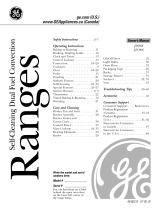Consumer Support Troubleshooting Tips Care and Cleaning Operating Instructions Safety Instructions
Using the oven.
To avoid possible burns, place the shelves in the desired position before you turn the oven on.
Before you begin…
The shelves have stop-locks, so that when
placed correctly on the shelf supports (A
through F), they will stop before coming
completely out, and will not tilt.
When placing and removing cookware,
pull the shelf out to the bump on the
shelf support.
On some models, the bake heating element
is under the oven floor. Do not place
foods on the oven bottom for cooking.
To remove a shelf, pull it toward you,
tilt the front end up and pull it out.
To replace, place the end of the shelf
(stop-locks) on the support, tilt up the
front and push the shelf in.
CAUTION: When you are using the shelf in the
lowest position (A), you will need to use caution
when pulling the shelf out. We recommend that
you pull the shelf out several inches and then,
using two pot holders, pull the shelf out by
holding the sides of it. The shelf is low and you
could be burned if you place your hand in the
middle of the shelf and pull all the way out. Be
very careful not to burn your hand on the door
when using the shelf in the lowest position (A).
The oven has 6 shelf positions.
Preheating and Pan Placement
Preheat the oven if the recipe calls for it.
Preheating is necessary for good results
when baking cakes, cookies, pastry and
breads.
To preheat, set the oven at the correct
temperature. The control will beep when
the oven is preheated and the display will
show your set temperature. This will take
approximately 10–15 minutes.
Baking results will be better if baking
pans are centered in the oven as much
as possible. If baking with more than one
pan, place the pans so each has at least
1″ to 1
1
⁄2″ of air space around it.
If baking four cake layers at the same time,
place two layers on shelf B and two layers
on shelf D. Stagger pans on the shelf so one
is not directly above the other.
Type of Food Shelf Position
Frozen pies (on cookie sheet) D
Angel food cake A
Bundt or pound cakes B or C
Biscuits, muffins, brownies, C or D
cookies, cupcakes, layer cakes, pies
Casseroles C or D
Turkey A
How to Set the Oven for Baking or Roasting
Touch the BAKE pad.
Touch the number pads to set
the desired temperature.
Touch the START pad.
NOTE: You will hear the convection fan
while the oven is preheating. The fan will
stop after the oven is preheated and the
display shows your set temperature.
This is normal.
Check food for doneness at
minimum time on recipe. Cook
longer if necessary.
Touch the CLEAR/OFF pad when
cooking is complete.
Do not place foods directly on the
oven floor.
Oven shelf
Flat shelf
12
Aluminum Foil
Do not use aluminum foil on the bottom
of the oven.
Never entirely cover a shelf with
aluminum foil. This will disturb the heat
circulation and result in poor baking.
A smaller sheet of foil may be used to
catch a spillover by placing it on a lower
shelf several inches below the food.





















